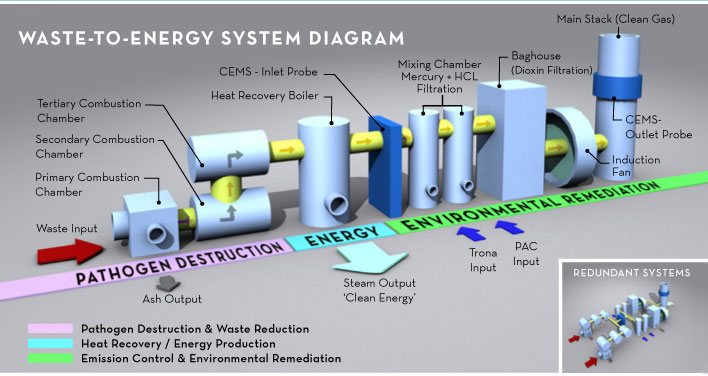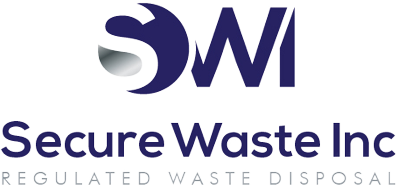Transforming Medical Waste into Clean Energy: Revolutionary Solutions From Secure Waste
Healthcare facilities across Maryland, Virginia, and Washington, D.C. are discovering a revolutionary approach to medical waste management that addresses two critical challenges: rising waste disposal costs and the urgent need for sustainable energy solutions. Medical waste-to-energy conversion technology represents a paradigm shift from traditional disposal methods, transforming potentially hazardous materials into valuable electricity while dramatically reducing environmental impact.
Transforming medical waste into clean energy offers healthcare facilities unprecedented benefits: up to 90% volume reduction, significant cost savings, and generating renewable electricity that can power facility operations. This breakthrough technology addresses the growing challenge of medical waste management while contributing to regional sustainability goals. For healthcare facilities in the Mid-Atlantic region, partnering with specialized providers like Secure Waste ensures access to cutting-edge waste-to-energy solutions that comply with strict federal regulations while maximizing operational efficiency.
The Growing Medical Waste Crisis in the Mid-Atlantic Region
Healthcare waste generation continues to surge across Maryland, Virginia, and Washington, D.C., with large hospitals producing over one ton of medical waste daily. Traditional disposal methods—primarily incineration without energy recovery and landfilling—represent missed opportunities for energy generation and cost reduction. The COVID-19 pandemic has further amplified these challenges, with monthly global consumption reaching 129 billion face masks and 65 billion gloves, creating an unprecedented volume of medical waste requiring proper management.
Modern waste-to-energy facilities can generate electricity sufficient to cover 50% or more of a healthcare facility’s operational needs, while simultaneously providing a complete solution for hazardous waste disposal. This dual benefit positions waste-to-energy as essential to sustainable healthcare operations in Maryland, Virginia, and Washington, D.C.
Understanding Medical Waste-to-Energy Conversion Technology
How the Waste-to-Energy Process Works
Medical waste-to-energy conversion employs sophisticated thermochemical processes to transform infectious and hazardous materials into usable electricity and thermal energy. The WTE process captures the heat generated by the combustion, which can heat water, generate steam, or make electricity via a steam-powered turbine. The energy generated can be used directly by the plant or exported to the local utility or nearby businesses.
The process begins with waste reception in specialized negative-pressure bunkers that control odor and prevent contamination. Medical waste undergoes controlled combustion at extremely high temperatures—typically 1,800°F to 2,200°F for medical waste streams—ensuring destruction of pathogens, bacteria, viruses, and hazardous compounds. The intense heat generates steam in sophisticated boiler systems, which drives turbines to produce electricity that can be used on-site or supplied to local utility grids.
Advanced Conversion Technologies Available
Thermal Treatment Systems are the most widely implemented technology, featuring rotary kiln incinerators with combined processing capacities exceeding 7,000 pounds per hour. These systems achieve remarkable efficiency, with one ton of waste yielding 550-700 kilowatt hours of electricity, sufficient to power a typical house for more than two weeks.
Plasma Gasification Technology offers advanced conversion capabilities, operating at temperatures between 3,000°F and 14,000°F using plasma torches. This process converts organic waste into synthesis gas (syngas) containing hydrogen and carbon monoxide, achieving 99% conversion rates while producing recyclable metals and glass-like slag as valuable byproducts.
Gasification and Pyrolysis Systems provide additional technological pathways for medical waste conversion. Gasification operates through thermochemical conversion at high temperatures with limited oxygen, producing syngas with efficiency rates ranging from 42% to 72%. Pyrolysis employs thermal decomposition in oxygen-free environments, generating bio-oil, biochar, and syngas with significantly lower emissions than traditional incineration.
Comprehensive Benefits for Healthcare Facilities
Environmental and Economic Advantages
Adopting waste-to-energy technology delivers transformative benefits across environmental, economic, and operational dimensions for healthcare facilities throughout Maryland, Virginia, and Washington, D.C.
Environmental Benefits:
- Reduces Landfill Waste: Converting waste to energy can substantially reduce the amount of waste entering landfills
- Volume Reduction: Medical waste-to-energy systems achieve volume reductions of 90% or more
- Pathogen Destruction: Destruction of pathogens and infectious agents at processing temperatures exceeding 1,000°C
- Emission Reduction: Modern facilities prevent the release of one ton of CO2 for every ton of waste processed
Economic Benefits:
- Energy Generation: The electricity generated can cover 50% or more of the plant’s operational needs
- Cost Reduction: Operational cost reductions of 44-50% in optimal configurations
- Revenue Streams: Excess electricity can be sold back to local utility companies
- Disposal Cost Elimination: Eliminates costly external waste disposal fees and transportation costs
Operational Advantages
Operational benefits include eliminating transportation risks associated with off-site disposal, reduced liability and compliance costs, and enhanced energy independence. On-site processing capabilities enable 24/7 waste handling while providing hot water and steam generation for facility use.
For healthcare facilities in the Mid-Atlantic region, Secure Waste’s specialized waste-to-energy solutions ensure that facilities across Maryland, Virginia, and Washington, D.C. can access these benefits while maintaining strict compliance with federal and state regulations.
Types of Medical Waste Suitable for Energy Conversion
According to the World Health Organization, medical waste includes infectious, pathological, chemical, pharmaceutical, cytotoxic, radioactive, non-hazardous, or general waste. Medical waste can be divided into two categories:
Hazardous waste, including chemical, toxic, explosive, pathogenic, or radioactive waste, represents the ideal feedstock for energy conversion. It contains approximately 15-20% of the total healthcare waste volume but provides substantial energy content. Pathological waste, infectious waste, pharmaceutical waste, and sharps containers all contribute valuable energy while requiring specialized handling.
Non-hazardous waste, including disposable masks and gowns, office materials, medical cotton waste, paper products, and cardboard, significantly increases processing volumes and energy generation potential. This waste provides substantial energy content through synthetic material composition while requiring less specialized handling.
Waste composition analysis reveals that medical waste contains approximately 4,000-5,000 kcal/kg of energy content. Healthcare facilities working with Secure Waste benefit from comprehensive waste stream analysis that optimizes energy conversion while ensuring complete regulatory compliance.
Problems with Traditional Medical Waste Management
Traditional medical waste management lacks comprehensive on-site waste treatment, resulting in significant environmental impact, increased costs, and missed opportunities for energy recovery. Contaminated materials are typically handled through:
- Off-Site Transportation: Transporting waste by refrigerated truck to external facilities for incineration, autoclaving, and landfilling
- Partial On-Site Treatment: Limited on-site disinfection before sending to external management companies
Both methods contribute to greenhouse gas emissions, health hazards, and environmental destruction while missing opportunities for energy recovery and cost reduction.
Advanced Technologies and Environmental Safeguards
Modern medical waste-to-energy facilities incorporate sophisticated technologies ensuring environmental protection while maximizing energy recovery efficiency.
Emission Control Systems include baghouse filters for particulate removal, lime injection systems for acid gas neutralization, and activated carbon injection for heavy metal removal. Nitrogen oxide reduction through ammonia injection ensures compliance with strict air quality standards.
Heat Recovery Technologies maximize energy recovery from combustion gases, achieving efficiency rates of 24.9% to 41.3% depending on system design and waste composition.
Environmental Protection Features include automatic dioxin and furan destruction at processing temperatures exceeding 1,000°C, mercury control through activated carbon injection, and advanced water treatment systems that utilize reclaimed water and comprehensive reuse systems.
Secure Waste’s advanced waste-to-energy facilities, which serve Maryland, Virginia, and Washington, D.C., incorporate these environmental safeguards as standard features, ensuring healthcare facilities can access clean energy generation while maintaining the highest environmental standards.
Economic Considerations and Return on Investment
The financial benefits of medical waste-to-energy conversion extend beyond cost reduction to encompass revenue generation and long-term operational advantages.
Capital Investment: Systems range from $680 to $1,026 per ton of annual processing capacity, with medical waste processing commanding premium pricing due to specialized handling requirements. However, these investments generate substantial returns through energy production, disposal cost elimination, and operational efficiency improvements.
Energy Economics: Facilities processing 1,500 tons annually can generate 60 megawatts equivalent of electricity, while syngas production reaches 3.13 cubic meters per kilogram of waste processed.
Cost Reductions: When waste-to-energy systems replace traditional disposal methods, operational cost reductions achieve 44.2% reductions in energy costs and 50.2% reductions in net present cost. Simple payback periods average 3 years and 1 month for thermal treatment systems.
For healthcare facilities in Maryland, Virginia, and Washington, D.C., Secure Waste provides comprehensive economic analysis demonstrating the financial benefits of waste-to-energy conversion.
Regulatory Compliance and Safety Standards
Medical waste-to-energy operations must comply with comprehensive federal, state, and local regulations, ensuring environmental protection and public safety.
Federal Compliance begins with EPA regulations under the Resource Conservation and Recovery Act (RCRA). Hospital, Medical, and Infectious Waste Incineration (HMIWI) facilities must meet federal emission standards for dioxins, furans, and heavy metals, with continuous monitoring requirements.
State and Local Requirements in Maryland, Virginia, and Washington, D.C. establish additional compliance obligations. Modern incinerators must operate at minimum temperatures of 850°C to 1,100°C with specialized gas-cleaning equipment.
Safety Protocols include comprehensive training requirements, emergency response procedures, and regular testing and monitoring protocols. Documentation and reporting requirements mandate comprehensive record-keeping for waste processing activities.
Secure Waste maintains comprehensive compliance programs that ensure all waste-to-energy operations meet or exceed regulatory requirements in Maryland, Virginia, and Washington, D.C.
Future Trends and Technological Innovations
The waste-to-energy industry continues evolving through technological advancements and increased focus on sustainability. Emerging conversion technologies include plasma gasification systems capable of processing 25-125 tons daily with 99% conversion efficiency.
Integration opportunities with renewable energy systems and smart grid technologies enable waste-to-energy facilities to contribute more effectively to regional energy infrastructure. Automation and artificial intelligence increasingly optimize combustion processes and emission control systems.
Modular system designs enable scaling from 25 tons per day to 125+ tons per day, providing flexibility for healthcare facilities of varying sizes. Circular economy integration expands waste-to-energy beyond simple conversion to encompass comprehensive resource recovery and materials management.
Secure Waste stays at the forefront of these innovations, ensuring regional healthcare facilities can access the most advanced waste-to-energy technologies available.
Why Choose Secure Waste for Medical Waste-to-Energy Solutions
Secure Waste offers comprehensive waste-to-energy solutions designed explicitly for Maryland, Virginia, and Washington, D.C healthcare facilities. With expertise in advanced waste treatment technologies, Secure Waste provides systems that eliminate all types of waste while generating valuable energy.
Comprehensive Service Offerings:
- Advanced treatment technologies with the latest environmental protection features
- Complete regulatory compliance management across all jurisdictions
- Detailed financial analysis demonstrating cost savings and revenue generation potential
- Environmental stewardship through advanced emission control and monitoring systems
Secure Waste’s deep understanding of Mid-Atlantic regional requirements ensures healthcare facilities receive solutions optimized for their specific operational needs and regulatory environment.
Call to Action: Transform Your Medical Waste Management Today
Medical waste-to-energy conversion represents a transformative solution for healthcare facilities across Maryland, Virginia, and Washington, D.C. It addresses critical challenges in waste management while generating valuable clean energy. The technology’s ability to achieve a 90% volume reduction, eliminate hazardous pathogens, and generate substantial electricity makes it an essential component of sustainable healthcare operations.
The compelling economics—including 44% operational cost reductions, energy generation covering 50% of facility needs, and elimination of external disposal costs—demonstrate clear financial benefits that complement environmental advantages.
Healthcare facilities seeking to optimize their waste management operations while contributing to regional sustainability goals should partner with Secure Waste. With expertise in cutting-edge waste-to-energy technologies and comprehensive compliance programs, Secure Waste provides healthcare facilities throughout the Mid-Atlantic region access to the most advanced medical waste-to-energy solutions available.
Contact Secure Waste today to discover how medical waste-to-energy conversion can transform your facility’s waste management operations while generating clean, renewable energy. Visit www.securewaste.net or call today to schedule your comprehensive waste-to-energy consultation for your Maryland, Virginia, or Washington D.C. healthcare facility.
Secure Waste provides comprehensive medical waste-to-energy solutions throughout Maryland, Virginia, and Washington, D.C. Our advanced technologies convert medical waste into clean electricity while ensuring complete regulatory compliance and environmental protection. Please get in touch with us today to learn how waste-to-energy conversion can reduce operational costs by up to 50% while generating renewable energy for your facility.

Expert Medical Waste Management: With over 25 years of industry experience, Secure Waste is a trusted local leader in hazardous and biohazardous waste disposal across Maryland, Virginia, and Washington, D.C. Specializing in medical waste management, sharps needle disposal, and biohazard waste removal, the company ensures full compliance with federal, state, and local regulations while prioritizing environmental sustainability.
The company also offers additional services, including secure document shredding and sharps container sales, providing comprehensive solutions for healthcare facilities and businesses. Our cost-effective services help clients maintain regulatory compliance without unexpected costs.
With a commitment to customer satisfaction, Secure Waste offers tailored waste management plans that align with industry best practices. Their team of experts provides reliable, timely, and compliant services, making them the preferred choice for medical waste disposal. For a free waste quote or more information, visit www.securewaste.net






